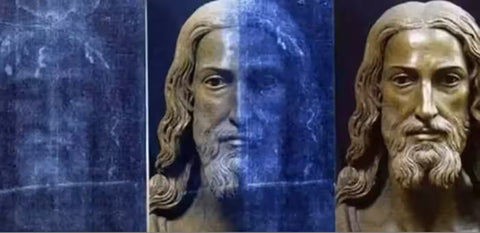The Shroud of Turin, a relic that has captivated humanity for centuries, sparks fascination, debate and contemplation. It is shrouded in a mystery as deep as the linen that wears it. This piece of fabric, kept in Turin, Italy, is reputed to have wrapped the body of Christ after his crucifixion. This article will delve into the historical, scientific and spiritual aspects surrounding this enigmatic shroud.

I- History of the Shroud of Turin
The story of the Shroud of Turin dates back to distant times, creating a historical framework that surrounds this exceptional religious relic.
-
Discovery and First Appearances: The shroud is believed to have been discovered in the Middle Ages, but the details of its first appearance remain unclear. Some accounts suggest it was preserved by Christian communities over the centuries, but it was not until the 20th century that its notoriety spread.
-
Moving Relics: Throughout its history, the Shroud has changed hands several times. Changes of ownership and geographical movements have punctuated its journey, contributing to its mystery and its status as a revered object.
-
Iconography of Christ: One of the most intriguing aspects of this relic is the ghostly image imprinted on it. Some consider it a representation of the face of Christ, while others remain skeptical about its divine origin.
-
Public Exhibition: Since the end of the 15th century, the Shroud of Turin has been exhibited several times, attracting pilgrims from all over the world. These public exhibitions were moments of intense devotion and ardent debates around its authenticity.
-
The 20th Century and Science: The advent of modern science has profoundly affected the perception of the shroud. Carbon-14 analyses, carried out in the 1980s, suggested a medieval dating, but these results have since been called into question.
-
Conservation and Current Exhibition: Currently preserved in Turin, the shroud is rarely exhibited to the public for preservation reasons. However, each exhibition reignites global interest and stimulates new discussions about its history and authenticity.
The story of the Shroud of Turin, full of mystery and intrigue, offers a unique perspective on how faith, science and history intertwine around this exceptional relic.

II- The Mystery of the Image on the Shroud
The mystery surrounding the image printed on the Shroud of Turin has been at the heart of debate and speculation for centuries. Several aspects of this image raise fascinating questions and provoke various interpretations.
-
Image Characteristics: The image on the shroud shows a wounded man, with crucifixion marks on his hands in the precise places that would be necessary for a man to be crucified as scientists of our century suggest, the feet and the side. These marks correspond to the suffering that Jesus would have suffered during his crucifixion according to the Gospel account.
-
Imprinting Process: How this image would have been printed on the fabric remains a matter of debate. Some put forward the hypothesis of a chemical reaction between the blood and chemicals naturally present in the shroud, while others consider the possibility of a still unknown phenomenon including light due to the resurrection of Christ, in short a divine miracle.
-
Exceptional Conservation: What amazes scientists and believers is the exceptional quality of the image. Unlike a painting or illustration, the image of the shroud shows no trace of brush or pigment, which raises questions about the artistic techniques of the time.
-
Scientific Debates: Scientific analyses, although limited by the fragility of the shroud, fueled the debates. While the carbon-14 results suggested a medieval dating, other research has called these conclusions into question, highlighting the complexity of analyzing this relic.
-
Theological Reflection: From a theological point of view, the image of the Shroud of Turin provokes profound reflections on the Passion of Christ. Believers see in it a tangible manifestation of the suffering endured by Jesus for the salvation of humanity.

III- Cultural and Religious Heritage: An Icon
The cultural and religious heritage of the Shroud of Turin contributes to its mystery, but also generates ardent debate. This icon, often seen as a tangible link to the crucifixion of Christ, raises questions and diverse interpretations within the believing community and beyond.
-
Pilgrimages and Devotions: The Shroud has been the focal point of many pilgrimages and religious ceremonies. Thousands of devotees have traveled to Turin to gaze at this relic, seeking inspiration and spiritual connection. For them, the shroud is much more than a simple piece of fabric; it is a window onto the sacred.
-
Theological Debates: On a theological level, the shroud sparks debate among religious scholars. Some see it as a physical manifestation of the Passion of Christ, thereby strengthening their faith in the central event of Christianity. Others, while recognizing its symbolic importance, insist on the need not to elevate it to the rank of sacred relic.
-
Artistic Influence: The image of Christ's face on the shroud has inspired many artists throughout the centuries. This iconic representation has shaped works of art, from sculptures to paintings, amplifying the transcendent character of the relic in Christian artistic culture.
-
Contemporary Challenges: In the age of modern science, the shroud faces severe challenges. Technological advances and scientific analysis methods call its authenticity into question. Some believers, while respecting its heritage, are ready to reconcile their faith with constantly evolving scientific discoveries.
-
Media Unveiling: The media coverage of the Shroud of Turin has amplified its status as a global enigma. Documentaries, articles and discussions fuel public curiosity, contributing to its fame but also to its critical examination. The shroud is thus at the heart of a complex dynamic between faith, science and public opinion.
-
Symbol of Mercy: Some believers see the shroud as a powerful symbol of divine mercy. The idea that the image was printed during the resurrection, at the moment when divine light would have penetrated the shroud, reinforces this vision. For them, he embodies God's immeasurable love for humanity.

IV- Unveiling the Mysteries: What Meaning for Believers?
Despite the controversies and debates surrounding the Shroud of Turin, believers grant it a profound meaning that transcends scientific debate. For them, this shroud is much more than a relic; it is a tangible sign of the divine presence and a manifestation of God's infinite compassion towards humanity.
-
Strengthening Faith: For many believers, the shroud strengthens their faith by providing a potential connection to the pivotal events of the Passion. The idea that this object could have been in direct contact with the body of Christ during his burial fuels a deep meditation on the mystery of Redemption.
-
Symbol of the Passion: The graphic representation of the face of Christ, marked by traces of suffering, is considered a powerful symbol of the Passion. Believers see in these marks the visual confirmation of the suffering endured by Jesus for the salvation of humanity.
-
Source of Inspiration: The Shroud of Turin is also a source of inspiration for many people in their spiritual journey. Contemplation of this relic can lead to deep meditation on the teachings of Christ and a search for a life more aligned with Christian values.
-
Call to Mercy: Some see in the shroud a call to divine mercy. The image of Christ, even in death, is seen as an invitation to turn to mercy, to understand the depth of God's love and to respond to this love with a life of compassion towards others.
-
Reminder of the Ephemeral: The fragility of the shroud reminds believers of the ephemeral nature of earthly life. This encourages reflection on life priorities and choices, stimulating a deeper search for meaning and a commitment to enduring spiritual values.
-
Faith and Science Dialogue: For some believers, dialogue between faith and science is an opportunity rather than a challenge. They see the scientific investigations of the shroud as an opportunity to strengthen their faith by showing that science and spirituality can coexist harmoniously.
-
Opening to the Mystery: Finally, the Shroud of Turin reminds believers that the Christian faith is intrinsically linked to mystery. Far from being a merely material object of worship, it opens a door to contemplation of the divine, inviting believers to immerse themselves in the mystery of their faith.
Thus, for many believers, the shroud represents an interface between the material and the spiritual, providing an opportunity for meditation, inspiration and strengthening of faith. Its meaning goes far beyond scientific debates, being part of a broader dimension of spiritual quest and relationship with the divine.






